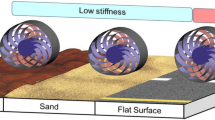Abstract
In order to measure friction coefficients of tire grounding surfaces in car running, a simple cantilever-type tactile sensor that can detect the vertical load and friction force applied to the sensing part as well as direction of the friction force, simultaneously, has been proposed. The present study equips the proposed sensor to a tire and confirms that the sensor can measure the friction coefficient of the tire grounding surface. For this purpose, measurements in this study were conducted using a sensor under a similar load as that of a common automobile travelling in an arbitrary direction. In order to perform the experiments under a high load in an arbitrary direction, we developed a parallel mechanism-type tire-driving device. The developed device can apply a high load to the tire in an arbitrary direction and can measure the vertical load, friction force, and the direction of the friction force applied to the tire involving the sensor. Thus, the measurement accuracy of the proposed sensor can be verified by comparing the output of the sensor to that of the driving device. As a result of this study, we clarified that the measurement values of the sensor are affected by the deformation of the tire, and proposed a method for correcting the effect of the tire deformation. By introducing the proposed correction method to the measurement of the sensor, it was confirmed that the friction coefficients of various surfaces can be measured with sufficient accuracy under a practical high-load condition.















Similar content being viewed by others
References
Han K, Hwang Y, Lee E, Choi S (2016) Robust estimation of maximum tire-road friction coefficient considering road surface irregularity. Int J Automot Technol 17:415–425
Chen L, Bian M, Luo Y, Qin Z, Li K (2015) Tire-road friction estimation based on frequency characteristics of in-wheel electric drive system. EVS28 international electric vehicle symposium and exhibition, pp 1-11
Yoon JH, Li SE, Ahn C (2016) Estimation of vehicle sideslip angle and tire-road friction coefficient based on magnetometer with GPS. Int J Automot Technol 17:427–435
Müller S, Uchanski M, Hedrick K (2004) Estimation of the maximum tire-road friction coefficient. J Dyn Sys Meas Control 125:607–617
Lua CA, Castillo-Toledo B, Cespi R, Di Gennaro S (2014) Tyre-road friction coefficient estimation based on tyre lateral deflection. Memorias del XVI Congreso Latinoamericano de Control Automático, CLCA 2014:1089–1094
Yilmazoglu O, Brandt M, Sigmund J, Genc E, Hartnagel HL (2001) Integrated Inas/gasb 3D magnetic field sensors for the intelligent tire. Sensors Actuators A 94:1269–1276
Savaresi SM, Tanelli M, Langthaler P, Del Re L (2008) New regressors for the direct identification of tire deformation in road vehicles via “in-tire” accelerometers. Control Syst Technol IEEE Trans 16:769–780
Sergio M, Manaresi N, Tartagni M, Canegallo R, Guerrieri P (2006) On a road tire deformation measurement system using a capacitive–resistive sensor. Smart Mater Struct 15:1700–1706
Matsuzaki R, Todoroki A (2006) Passive wireless strain monitoring of actual tire using capacitance–resistance change and multiple spectral features. Sensors Actuators A 126:277–286
Matsuzaki R, Keating T, Todoroki A, Hiraoka N (2008) Rubber-based strain sensor fabricated using photolithography for intelligent tires. Sensors Actuators A 148:1–9
Hiraoka N, Matsuzaki R, Todoroki A (2009) Concurrent monitoring of in-plane strain and out-of-plane displacement of tire using digital image correlation method. J Solid Mech Mater Eng 3:1148–1159
Matsuzaki R, Hiraoka N, Todoroki A, Mizutani Y (2010) Optical 3D deformation measurement utilizing non-planar surface for the development of an intelligent tire. J Solid Mech Mater Eng 4:520–532
Matsuzaki R, Hiraoka N, Todoroki A, Mizutani Y (2012) Strain monitoring and applied load estimation for the development of intelligent tires using a single wireless CCD camera. J Solid Mech and Mater Engineering 6:935–949
Tuononen AJ (2011) Laser triangulation to measure the carcass deflections of a rolling tire. Meas Sci Technol. doi:10.1088/0957-0233/22/12/125304
Ise T, Higuchi M, Tachiya H (2013) Development of a tactile sensor to measure tire friction coefficients in arbitrary directions. Int J Autom Technol 7:359–366
Wallman CG, Åström H (2001) Friction measurement methods and the correlation between road friction and traffic safety: a literature review. VTI meddelande 911A
Author information
Authors and Affiliations
Corresponding author
Rights and permissions
About this article
Cite this article
Ise, T., Higuchi, M., Suzuki, Y. et al. Measurement on Friction Coefficients of Tire Grounding Surface in Arbitrary Directions under High-Load. Exp Mech 57, 1383–1393 (2017). https://doi.org/10.1007/s11340-017-0309-8
Received:
Accepted:
Published:
Issue Date:
DOI: https://doi.org/10.1007/s11340-017-0309-8



